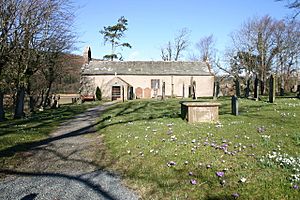St John's Church, Waberthwaite facts for kids
Quick facts for kids St John's Church, Waberthwaite |
|
|---|---|

St John's Church, Waberthwaite, from the south
|
|
| Lua error in Module:Location_map at line 420: attempt to index field 'wikibase' (a nil value). | |
| OS grid reference | SD 100 951 |
| Location | Waberthwaite, Cumbria |
| Country | England |
| Denomination | Anglican |
| Website | St John, Waberthwaite |
| History | |
| Status | Parish church |
| Architecture | |
| Functional status | Active |
| Heritage designation | Grade II* |
| Designated | 8 September 1967 |
| Architectural type | Church |
| Specifications | |
| Materials | Roughcast stone, slate roofs |
| Administration | |
| Parish | Waberthwaite |
| Deanery | Calder |
| Archdeaconry | West Cumberland |
| Diocese | Carlisle |
| Province | York |
St John's Church is a historic building located in a small village called Hall Waberthwaite. It sits by the River Esk in Cumbria, England. This church is an active Anglican parish church, meaning it's a local church where people go for services. It's part of a group of churches that work together, including St Paul's, St Michael's, and St Catherine's. St John's Church is very important because it's listed as a Grade II* building. This special listing means it's a particularly important building of more than special interest.
Contents
A Long History
St John's Church is very old, likely built in the 1200s. Over the years, parts of it have been changed and added. But even before the church was built, this spot was a religious place. We know this because there are pieces of ancient crosses from the 800s and 900s in the churchyard.
Church Design
The church is built from stone that has a rough coating, and its roofs are made of slate. It has a simple design, with one main room that serves as both the chancel (the area near the altar) and the nave (where the people sit). There are no dividing walls or arches inside. A small room called a vestry is attached to the north side. The main entrance is on the south side, covered by a porch. This porch was rebuilt in 1825.
Inside the Church
When you go inside, you'll see an eight-sided wooden pulpit. It has beautiful carvings and a special message written on it. The message says, "THE GIFT OF ABRAHAM CHAMBERS GENT. VA(E) MIHI SI NON VERUM PRAEDICO." This means "Woe to me if I preach not the truth." It also has the initials S.R. and the date 1630. S.R. might have been Samuel Rutter, who was a church leader here and later became a bishop.
The baptismal font is a large, hollowed-out stone block lined with lead. It has a square shape and a wooden lid. On the north wall, you can see the royal arms of George III, who was king a long time ago. In 1807, the church's interior was updated with special enclosed seating areas called box pews. The floor was covered with flat stones, and the ceiling was finished. Interestingly, the old oil lamps were kept and changed to work with electricity.
Outside the Church
On the west end of the church, there's a small tower called a bellcote. It holds two bells that are very old, from the 1400s! These bells were kept when the bellcote was fixed up in 1796. The larger bell has an inscription that says "SANCTUS JACOBUS" (Saint James) and "DOMINUS THOMAS WALKER" (Sir Thomas Walker). Thomas Walker was the church's rector from 1439. The smaller bell says "HENRICUS SEXTUS REX" (King Henry the sixth).
We don't know if King Henry VI gave these bells to the church or if they were just put in during his time as king (1422 to 1471). Either way, it helps us guess when they were installed. It's interesting that one bell is named after Saint James. In 1392, the church was actually called St James's. This suggests that the church might have been dedicated to Saint James first, and then later changed to St John after Henry VI's reign.
Churchyard Discoveries
In the churchyard, you can find parts of two very old stone crosses. These are called Anglo-Scandinavian high cross shafts. Experts believe one fallen cross shaft is from between 850 and 925. The standing cross shaft shows strong Norse (Viking) influences and is thought to be from around 950. Both crosses have carvings on all sides. The fallen one was used as a doorstep for a long time, so one side is very worn. The standing cross was found in 1825 and used as a lintel (a beam over a doorway). It was later put back in its correct spot with its base between 1884 and 1889. This standing cross is now a protected historical site.
The churchyard also has a tall sundial, which is like a clock that uses the sun's shadow. It's about 5 feet 6 inches tall. An inscription says it was made in 1830 by Watkins and Hill of London for a Reverend J. Stanley. It's set up for the specific location of the church. The sundial has a brass pointer (called a gnomon) and a round brass plate with hours and minutes marked. It even has a scale for months and days.
A Bell from Another Place
Inside the church, on the sill of the west window, there's another bell. This bell originally came from the Chapel of St. Luke, which used to be in Waberthwaite. The bell is dated 1882. It was moved to St John's Church when the chapel was taken down.
Gallery
See also
- Grade II* listed buildings in Cumberland
- Listed buildings in Waberthwaite






